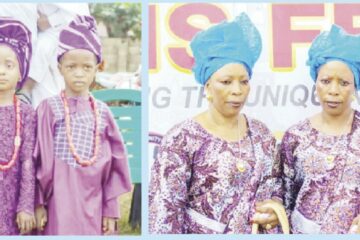The egungun festival is a part of the Yoruba traditional religion. It is performed to mark the death of important personalities, the festival is common among the Egbas, Egbados, Oyo and other parts of southwestern Nigeria. The festival is usually an annual celebration performed within the months of November to April when there is no rain, with the belief that their ancestor should not have to surfer in the rain.
The history of egungun is traceable to the then Alaafin Sango in the old Oyo Empire. Basically, Alaafin Sango did not want to lose contact with his dead maternal lineage in Tapa land when he became the Alaafin.
The thought of symbolic representation of the dead via a social costumed dressing to protect the identities of the people from his mother’s Tapa home came to him. This Egungun was adopted by various Yoruba sub-ethnic groups as an avenue to communicate with the spirit of their dead ones.
Cloth plays an important role in the world of the Yoruba. Their beliefs equate nakedness with infancy, insanity, or the lack of social responsibility. More elaborate dress reflects social power and prestige. In performances honouring ancestors, exquisite cloth is the major medium for the masker’s transformation. An egungun costume is composed of multiple layers of cloth lappets made from expensive and prestigious textiles, expressing the wealth and status of a family as well as the power of the ancestor.
The composition of an Egungun ensemble has several distinctive features. The layer worn closest to the masker’s skin, the under sack, must be made of Aso-Oke, the indigo and white strip-cloth (Fig. 6). It closely resembles the shroud in which the dead are wrapped. This sack, along with the netting for the face and hands, must completely seal the masker’s body. The netting effectively disguises facial and hand features that might disclose his identity.
On top of this base are placed the layers of lappets. As the masker whirls, the lappets are sent flying, creating a “breeze of blessing.” The design of the costume is therefore closely related to the choreography of the performance. Henry Drewal hypothesizes that the breeze of blessing created by the egungun may also relate to Oya, the wife of Sango, the deified fourth king of Oyo and the god of thunder.[7][8] Oya is the whirlwind, considered a wind of blessing, that precedes Shango, the storm.
The festival is set off when the Chief priest of the Egugun Masquerades invokes the spirit of the ancestors, this act is known as” Alapi”, it is done when the egungun masquerade and worshippers dance, drum and are now possessed by the ancestral spirit. The Egungun masquerade is dressed in colourful regalia with a whip, which is used to flog anyone in the way of the spirits.
The Aworis see the egungun as their deity and as such worship egungun. Women are not allowed to put on the egungun regalia although they constitute important aspect of Egungun group preparing the celebration of egungun festivals. egungun masquerades are male dominated within the performance aspect and only males are allowed to connect with the spirits in Egungun by transforming into the masked figure. Women are prevalent in creating the materials, dramatizing the performance, singing, dancing, and watching. Elders say that separation is necessary because of the dangers of women power.
They sing, clap and chorus the traditional songs. The women constitute a formidable team in the group. They are Iya agba oje. The elders of the ‘Oje’ while the young ones are known as Ode-Oje (The youthful Oje). Oloponda is the traditional head of all Egunguns in Ota.
The festival is believed to help foster unity in the community and it is also Economically beneficial.





